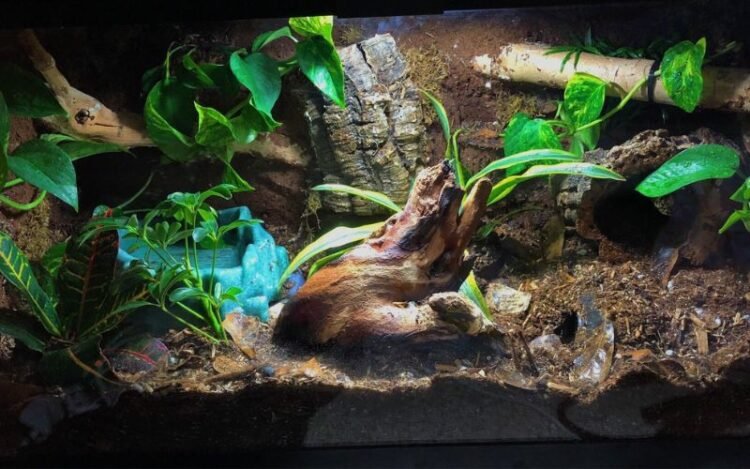
The plants you use to decorate your terrarium are an important part of making it the right environment for your ball python. They not only make the enclosure look better, but also make reptiles feel more secure and at home in their natural habitat. To provide you with all the information you need to create an attractive and gratifying home for your pet ball python, this article will examine the best ball python terrarium decoration plants in 2023.
How To Choose Best Ball Python Terrarium Decor Plants in 2023?
Choosing the right plants is important if you want to provide a stimulating and natural environment for your ball python terrarium. Some things to consider when choosing plants:
Select vegetation that will thrive in the allotted space of your terrarium. Don’t put your ball python at risk by choosing plants that will quickly drain or limit his movement in the enclosure.
Your pet’s safety depends on your selection of non-toxic plants. There have been reports of ball pythons munching on plants, which can be dangerous if they eat any poisonous leaves.
Low maintenance: Choose vegetation that requires minimal attention and work. This will make it easier for you to give your ball python’s environment the care it needs.
Best Ball Python Terrarium Decor Plants in 2023
Snake Plant (Sansevieria Trifasciata)
The snake plant, or Sansevieria trifasciata, is a great addition to a terrarium for keeping a ball python. Its long, narrow leaves stand proudly, making it an eye-catching addition to any garden. Plus, snake plants are excellent air purifiers, so your ball python can rest well in a pristine setting.
Snake plants are low-maintenance houseplants because they require little water and can thrive in low light. Because of this, they are great for people who are just starting out or who don’t have a lot of time to care for plants.
Pothos (Epipremnum Aureum)
The scientific name of this plant, commonly known as “pothos”, is Epipremnum aureum. Pothos with its heart-shaped leaves and trailing vines brings a touch of greenery and natural beauty to the enclosure.
The adaptability of pothos to many lighting conditions, especially low light, is a major advantage. Because of its rapid spread, pruning may be needed from time to time to keep it under control. The toxin-filtering pothos is a bonus, making it a great choice for your ball python’s environment.
Spider Plant (Chlorophytum Comosum)
The spider plant, or Chlorophytum comosum as it is known in the scientific community, is another popular addition to ball python’s terrariums. The enclosure feels more sophisticated by the inclusion of spider plants, whose long, arching leaves are adorned with white stripes.
Spider plants require little attention and can thrive in a variety of light conditions. In addition to well-draining soil, they also demand partial or bright, indirect sunlight. Air purification is another benefit of spider plants that will benefit your ball python’s habitat.
Aloe Vera (Aloe Vera)
The beautiful and useful aloe vera plant can be a great asset to your ball python’s terrarium. Due to the gel-like substance found in its fleshy, spiky leaves, it can be used to treat minor burns and irritations on your pet.
Aloe vera requires well-draining soil and thrives in indirect, bright sunlight. Because of their different moisture requirements, aloe vera plants and your ball python should be kept in separate containers.
Conclusion
It is important to the health of your ball python that it be provided with an interesting and stimulating environment. The best plants for ball python terrarium decorations in 2023 include snake plants, pothos, spider plants, and aloe vera, and together they provide an attractive setting that is reminiscent of the ball python’s natural habitat. Make sure the plants you choose are safe, easy to care for, and appropriate for the confines of your terrarium.
Make sure you learn about the specific needs of each plant and keep a close eye on its growth. A thriving terrarium that supports a happy and healthy existence for your beloved pet ball python can be created by paying attention to the demands of your pet and the plants selected.
FAQs
Can I replace real plants with fake plants in my ball python’s terrarium?
To answer your question, artificial plants can be replaced with real plants. They won’t be eaten by your ball python and require little care. However, real plants offer additional benefits, such as cleaner air and a more authentic feel.
Can you recommend any additional plants that will not harm the ball python?
Bromeliads, dracaena, and ZZ plants are just a few examples of other plants that can coexist with ball pythons. Before adding a new plant to your ball python’s habitat, be sure you understand its needs and potential toxicity.
How often should I water the plants in the terrarium for my ball python?
The size of the terrarium, the type of plants you’re growing, and the relative humidity all play a role in how often you’ll need to water them. Soil moisture should be checked frequently, and plants should be watered when the top layer feels dry. It is important to find a happy medium between under-watering and over-watering to prevent root rot.
